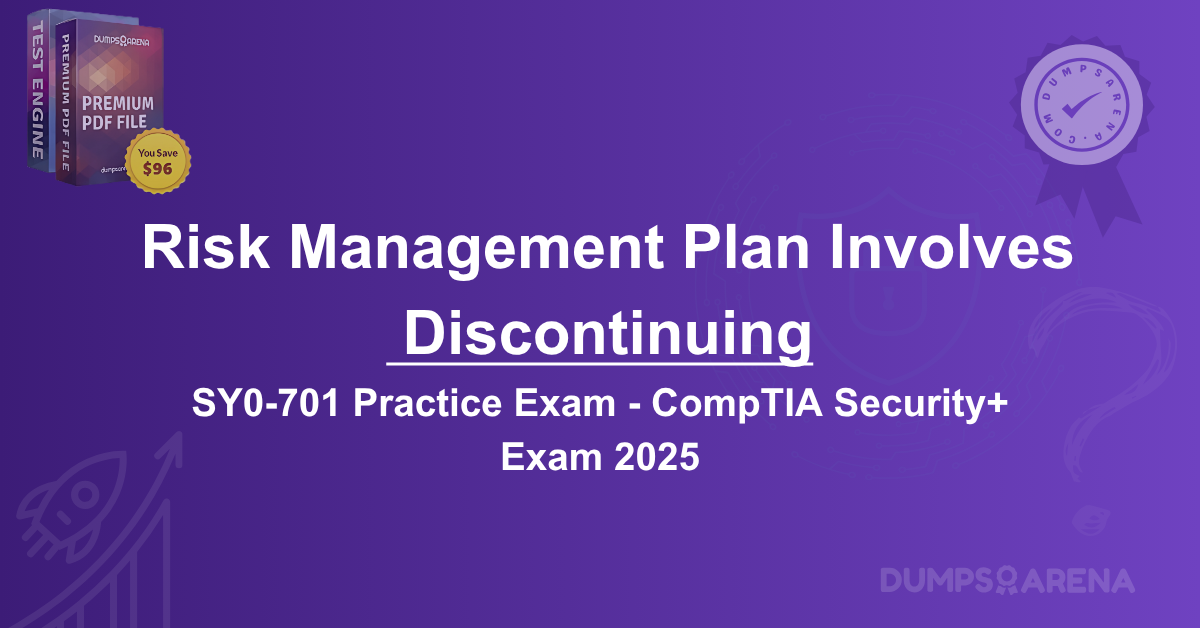Introduction
In the ever-evolving world of business, risk is an inevitable component. Whether it's related to cybersecurity, operational procedures, legal compliance, or market uncertainties, organizations must manage risk strategically to ensure survival and success. This is where risk management planning comes into play. A strong risk management strategy not only safeguards assets and reputations but also empowers organizations to make bold and informed decisions.
At DumpsArena, we understand the value of mastering professional risk concepts, especially for those preparing for exams or certifications that assess knowledge in areas such as risk analysis, project management, and IT governance. One of the most frequently misunderstood concepts is the idea of discontinuing an activity that creates risk. So, which risk management plan actually supports that approach?
This blog will provide an in-depth explanation of the concept, guide you through relevant planning strategies, and clarify how discontinuing a risky activity fits into the larger risk management landscape. If you're preparing for an exam or simply wish to sharpen your risk-related knowledge, this resource, powered by DumpsArena, is your ultimate guide.
Understanding Risk Management in Detail
Before diving into the core question, it's important to establish a comprehensive understanding of what risk management is and why it matters. Risk management is a systematic process used by organizations to identify, assess, and control threats to their capital and earnings. These risks could stem from a variety of sources, including:
-
Financial uncertainties
-
Legal liabilities
-
Technological failures
-
Strategic management errors
-
Natural disasters
The ultimate goal of risk management is to protect the organization while still allowing it to thrive. Multiple strategies can be used to handle risk, and each is selected based on factors such as the severity of the risk, its likelihood, and the cost of addressing it.
The Four Primary Risk Management Strategies
Every organization customizes its approach to risk, but generally speaking, there are four widely recognized strategies used in risk management:
1. Risk Avoidance
2. Risk Reduction
3. Risk Sharing (or Transfer)
4. Risk Retention (or Acceptance)
Each of these strategies plays a unique role in the overall risk management plan. For this discussion, we will explore these strategies in more depth to identify which one involves discontinuing an activity entirely.
What Is Risk Avoidance?
Risk avoidance is a proactive strategy that involves identifying and then completely removing the risk by avoiding the activity that causes it. This approach is the answer to the question: "Which risk management plan involves discontinuing an activity that creates a risk?"
Yes, it’s risk avoidance.
In this strategy, the organization opts not to engage in the activity that carries a high level of risk. For example, a company may decide not to expand operations into a country with an unstable political climate, thereby avoiding potential legal and economic problems.
Unlike risk reduction, which attempts to minimize the impact or likelihood of risk, risk avoidance eliminates the risk by avoiding the root cause.
Risk Avoidance in Real-World Contexts
Risk avoidance isn't just theoretical; it's widely practiced in various industries. Let’s explore some practical examples:
Business Expansion
A startup may choose not to enter a heavily regulated international market where compliance risks are high. By avoiding entry into that market, the startup avoids legal penalties and reputational harm.
Cybersecurity
A company might avoid using third-party applications that have not been thoroughly vetted, thereby eliminating the risk of data breaches.
Project Management
Project managers may avoid using untested software in mission-critical projects. Instead, they use proven solutions to ensure project success.
In each of these scenarios, the entity discontinues or refrains from initiating an activity that poses a significant risk. This is pure risk avoidance in action.
When Should Risk Avoidance Be Used?
Although risk avoidance sounds like the safest bet, it is not always the best course of action. It’s usually adopted when:
-
The risk outweighs the benefits of the activity.
-
There are no feasible solutions for mitigating or transferring the risk.
-
Resources or capacities are limited, and risk tolerance is low.
-
Regulatory or legal frameworks strongly discourage taking on the risk.
That said, avoidance can also come with missed opportunities. For example, not launching a new product because of uncertain market demand could mean losing a competitive edge.
Therefore, organizations must evaluate not only the risk but also the cost of avoidance, which can sometimes be as significant as the risk itself.
Alternatives to Risk Avoidance
To give a complete picture, let’s briefly look at the other strategies and how they differ from avoidance.
Risk Reduction
This involves minimizing the likelihood or impact of risk rather than removing it entirely. For example, installing fire suppression systems in a factory doesn't eliminate fire risks, but it reduces the potential damage.
Risk Sharing (Transfer)
This approach moves the risk to another party. Common examples include insurance policies and outsourcing. You don't remove the risk—you just make it someone else’s problem (contractually speaking).
Risk Retention (Acceptance)
In this case, the organization decides to accept the risk because it's either too small to matter or too expensive to address. For instance, a company may accept the risk of occasional software bugs if fixing them is cost-prohibitive.
Each of these strategies has its place, but only risk avoidance fully discontinues the activity that generates the risk.
Risk Avoidance in the Context of Certification Exams
For students and professionals preparing for industry certifications—especially those related to cybersecurity, project management, and compliance—understanding the concept of risk avoidance is crucial. Certification bodies frequently test your understanding of how to apply risk management strategies to real-world scenarios.
At DumpsArena, we offer the most updated and realistic exam materials tailored for these certifications. Our resources are designed to reinforce your understanding of these concepts through practice questions, scenario-based learning, and simulated test environments.
Let’s explore how this topic may appear in a real certification exam.
How DumpsArena Helps You Master Risk Management Concepts?
Whether you're pursuing a PMP certification, a CISSP credential, or an audit-focused qualification like CISA or CRISC, risk management is a foundational topic. At DumpsArena, we specialize in providing you with:
-
Comprehensive exam dumps that reflect real exam questions
-
Up-to-date materials based on the latest exam syllabi
-
Scenario-based questions to train you in practical decision-making
-
In-depth explanations for correct and incorrect answers
We don’t just help you memorize—we help you understand, which is crucial for questions like the one covered in this blog.
Common Misconceptions About Risk Avoidance
Despite its clarity, risk avoidance is often misunderstood. Let's address some of the common myths:
“Avoidance is always the safest option.”
Not necessarily. Avoidance can lead to lost revenue, reduced innovation, and stagnation. It’s only effective when the risk is unacceptable and uncontrollable.
“Avoidance means failure to act.”
That’s incorrect. Avoidance is a strategic and deliberate decision, not a passive one. It’s about choosing not to act for a calculated reason, not out of fear or indecision.
“You can avoid all risks.”
Impossible. No business can avoid all risks. Risk avoidance should be used selectively, for critical threats, not as a blanket policy.
By understanding the nuances of this strategy, candidates can avoid falling into traps during their certification exams and apply better judgment in real-world situations.
Conclusion
The question “Which risk management plan involves discontinuing an activity that creates a risk?” has a clear and definitive answer: Risk Avoidance. This strategy stands out by choosing to eliminate risk at its source by completely avoiding the activity that introduces it. While this approach may seem conservative, it is often the most appropriate course of action when the stakes are high and mitigation options are either non-existent or prohibitively expensive.
Question 1:
Which of the following is the primary purpose of a firewall in a network security system?
A. Encrypting sensitive data
B. Blocking unauthorized network traffic
C. Creating secure tunnels for remote access
D. Implementing data loss prevention policies
Question 2:
Which of the following attack types involves sending fraudulent messages to deceive a recipient into revealing sensitive information?
A. Phishing
B. Spoofing
C. Man-in-the-middle
D. SQL Injection
Question 3:
Which of the following encryption algorithms is commonly used for securing wireless communication?
A. RSA
B. AES
C. DES
D. Blowfish
Question 4:
What is the main purpose of multi-factor authentication (MFA)?
A. To use biometric data for secure access
B. To enforce stronger password policies
C. To require two or more forms of verification to access a system
D. To encrypt sensitive information during transmission
Question 5:
Which type of malware is specifically designed to allow unauthorized remote access to a computer system?
A. Virus
B. Worm
C. Trojan Horse
D. Rootkit
Question 6:
Which of the following is a fundamental element of risk management in security?
A. Risk mitigation
B. Risk avoidance
C. Risk assessment
D. All of the above
Question 7:
Which of the following security protocols is used to protect the integrity and confidentiality of emails?
A. HTTPS
B. PGP
C. IPsec
D. SNMP
Question 8:
What is the most common method used to defend against Distributed Denial of Service (DDoS) attacks?
A. Firewalls
B. Intrusion Detection Systems (IDS)
C. Load balancing and traffic filtering
D. Antivirus software
Question 9:
Which of the following would MOST likely be used to detect and prevent unauthorized access to a network?
A. Network Access Control (NAC)
B. Anti-virus software
C. File Integrity Monitoring (FIM)
D. Security Information and Event Management (SIEM)
Question 10:
Which of the following describes the principle of least privilege?
A. Giving users the maximum permissions to perform their tasks
B. Restricting users’ access to only the resources they need to perform their job functions
C. Sharing passwords among trusted employees
D. Allowing employees access to all network resources for flexibility
Visit DumpsArena for the latest CompTIA Security+SY0-701 Exam Dumps, study guides, and practice tests to guarantee your certification success!




